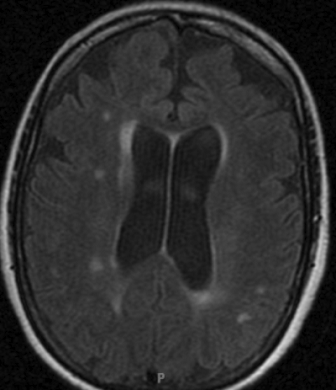Check out today’s Step 1 Qmax Question Challenge.
Know the answer? Post it below! Don’t forget to check back for an update with the correct answer and explanation (we’ll post it in the comments section below).
 A 26-year-old woman presents to her primary care physician with a 2-week history of pain in her right eye. During the physical examination, the patient is noted to have hyperemia and edema of her right optic disc. On further questioning, the patient also complains of intermittent weakness for the past several months. Neurologic examination reveals 5/5 strength in the left upper extremity, 4/5 in the right upper extremity, 4/5 in the right lower extremity, and 5/5 in the left lower extremity. She undergoes an MRI, which is shown in the image.
A 26-year-old woman presents to her primary care physician with a 2-week history of pain in her right eye. During the physical examination, the patient is noted to have hyperemia and edema of her right optic disc. On further questioning, the patient also complains of intermittent weakness for the past several months. Neurologic examination reveals 5/5 strength in the left upper extremity, 4/5 in the right upper extremity, 4/5 in the right lower extremity, and 5/5 in the left lower extremity. She undergoes an MRI, which is shown in the image.
Which of the following cerebrospinal fluid studies would be consistent with the patient’s diagnosis?
A. Increased protein, normal WBC count
B. Increased protein, oligoclonal bands
C. Increased protein, protein 14-3-3
D. Increased WBC count, herpes simplex virus polymerase chain reaction
E. Normal protein, JC virus DNA
———————–
Want to know the ‘bottom line?’ Purchase a USMLE-Rx Subscription and get many more features, more questions, and passages from First Aid, including images, references, and other facts relevant to this question.
This practice question is an actual question from the USMLE-Rx Step 1 test bank. For more USMLE Step 1 prep, subscribe to our Flash Facts and Step 1 Express video series. Score the best deal on all three products with a Step 1 Triple Play Bundle.




B
Wouldn’t oligoclonal bands be characteristic of MS? In which case we would see random opacities on MRI? If I had to guess I would say D
B
Sclerae + IgG bands (MS)
B MS
B
B
Answer @fa!?